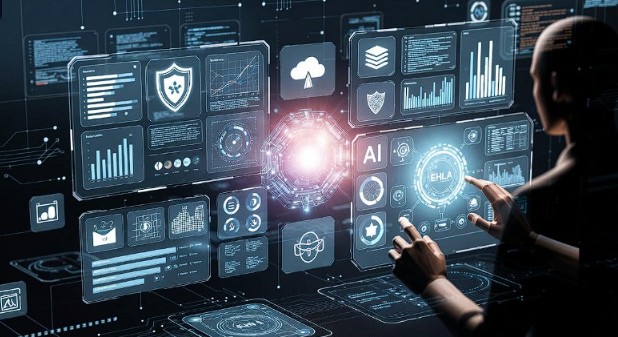
The cryptocurrency market has transformed dramatically, with automated systems now executing 70-80% of all trades. AI-powered trading systems process over $50 billion in daily volume, analyzing market conditions at speeds impossible for humans. These technologies monitor multiple exchanges simultaneously, executing trades within milliseconds while reducing transaction costs by up to 32%. Modern AI bot trading solutions leverage big data to identify patterns, predict movements, and implement strategies with unprecedented precision, fundamentally reshaping how digital asset markets operate.
What are AI trading bots?
AI trading bots represent the convergence of artificial intelligence and financial technology, creating automated systems that can analyze market trends and execute trades with minimal human intervention. Unlike traditional trading methods that rely on predefined rules, modern AI bots utilize sophisticated algorithms and machine learning techniques to continually adapt their strategies based on market dynamics.
These systems can process enormous amounts of data in milliseconds, identifying patterns and opportunities that would remain invisible to human traders. Operating continuously across all 365 days of the year, they monitor over 500 trading pairs simultaneously while executing trades within 50 milliseconds of identifying an opportunity.
The market for these technologies is expanding rapidly, with projections indicating growth to $4.2 billion by 2026, advancing at a compound annual growth rate of 21.5%. This expansion reflects both the increasing sophistication of the technology and its proven effectiveness in enhancing trading performance through automation, with well-configured systems achieving win rates of 60-65% in trending markets.
The role of big data in AI trading
Big data serves as the foundation upon which effective AI trading systems are built. In the context of trading, big data encompasses vast collections of market information, including historical price movements, trading volumes, order book data, and market indicators from multiple exchanges.
“AI trading algorithms process market data 400 times faster than human traders, analyzing over 400,000 data points per second across multiple exchanges.”
This exponential increase in data processing capability creates significant competitive advantages. By ingesting and analyzing massive datasets in real-time, trading bots can detect subtle market patterns that would otherwise remain invisible. These systems transform raw information into actionable trading signals with remarkable speed and precision.
The data utilized extends beyond price information to include diverse sources such as news reports, social media sentiment, and economic indicators. This comprehensive approach allows AI systems to develop a more nuanced understanding of market dynamics, leading to more accurate predictions and better-informed trading decisions that can adapt to changing market conditions almost instantaneously.
How AI trading bots process and analyze data
The processing pipeline for AI trading bots begins with extensive data collection and preprocessing. These systems gather real-time information from multiple sources, cleaning and normalizing the data to ensure accuracy and consistency before analysis occurs.
Once preprocessed, the data passes through sophisticated analytical models that employ various strategies including:
- Technical analysis using indicators like Moving Averages, RSI, and MACD
- Statistical arbitrage to exploit price differences across exchanges
- Machine learning models including neural networks to predict market movements
- Sentiment analysis of news and social media to gauge market mood
These models generate trading signals through complex algorithms that evaluate multiple factors simultaneously, determining optimal entry and exit points for trades.
The most advanced systems implement continuous learning mechanisms, where the AI evaluates its own performance, learning from both successful and unsuccessful trades to refine future decisions. This adaptive capability represents a fundamental advantage over traditional systems, allowing the technology to evolve its strategies in response to changing market conditions rather than following rigid, predefined rules.
Key applications of big data in trading systems
High-frequency trading represents one of the most significant applications of big data in automated trading. These systems leverage computational speed to execute large numbers of orders within fractions of a second, capitalizing on minimal price movements that would be imperceptible to human traders.
Predictive analytics forms another crucial application, with AI models using historical and real-time data to forecast market trends with increasing accuracy. These forecasts enable more informed decision-making and strategic positioning ahead of anticipated market movements.
The primary data sources that power these applications include:
- Historical and real-time price data from multiple exchanges
- Order book information showing pending buy and sell orders
- Market sentiment indicators derived from news and social media
- Macroeconomic data including interest rates and GDP figures
- Trading volume patterns and liquidity metrics
Risk management systems also benefit tremendously from big data, allowing for dynamic portfolio adjustments that respond to changing market conditions. By continuously evaluating position exposure against market volatility, these systems can maintain optimal risk profiles while maximizing potential returns.
Performance metrics and success factors
When evaluating AI trading bots, several key performance metrics determine success. The Sharpe Ratio, which measures risk-adjusted returns, should ideally exceed 1.5 for effective systems. Maximum drawdown, representing the largest drop from peak to trough, should remain under 15% of total portfolio value to ensure sustainability.
Successful implementation requires appropriate capitalization, with experts recommending a minimum starting capital of $5,000-$10,000 for retail traders. Position sizing plays a crucial role in risk management, with each trade limited to 2% of total portfolio value.
Statistics show that 65% of bots fail within their first three months, primarily due to poor configuration and inadequate testing. The most successful implementations combine multiple technical indicators and undergo rigorous backtesting before deployment.
Challenges and limitations
Despite their sophistication, AI trading bots face significant challenges. Data quality issues represent a primary concern, as incorrect or outdated information leads directly to poor trading decisions. The technology also requires substantial computational resources and infrastructure, creating barriers to entry for smaller traders.
“While AI and automation provide unmatched leverage, relying solely on black box systems ignores inherent uncertainties.”
Adapting to unforeseen market events presents another critical limitation. During black swan events or extreme volatility, many algorithms struggle to adjust appropriately, potentially magnifying losses. Security vulnerabilities also pose risks, with sophisticated trading algorithms becoming targets for cyberattacks.
These limitations underscore the importance of maintaining human oversight rather than blindly trusting automated systems, regardless of their technological sophistication.
Future trends in AI trading and big data
The evolution of AI trading technology points toward increasing integration with quantum computing, which promises to exponentially increase data processing capabilities. This advancement will enable analysis of even larger datasets with greater speed and precision, potentially uncovering previously invisible market patterns.
Machine learning models continue to grow more sophisticated, with deep learning algorithms achieving ever-higher accuracy in predictive capabilities. Simultaneously, the democratization of these technologies is accelerating, making previously exclusive tools accessible to retail traders.
Regulatory frameworks will likely evolve in response, potentially creating new compliance requirements as automated trading continues to dominate market volume. This changing landscape will reward those who remain adaptable while maintaining sound risk management principles.
Conclusion
The marriage of AI and big data has fundamentally transformed cryptocurrency trading, creating systems capable of processing information, identifying patterns, and executing trades at scales impossible for human traders. These technologies offer unprecedented opportunities for improving efficiency and profitability while reducing emotional biases.
Write and Win: Participate in Creative writing Contest & International Essay Contest and win fabulous prizes.


